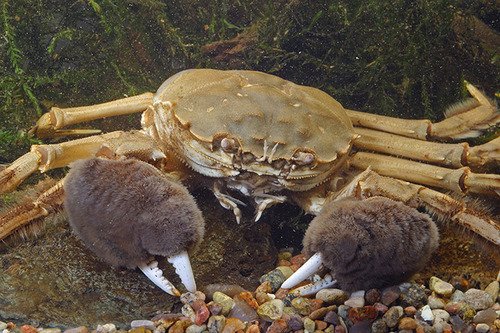Hitchhiking Across Oceans
Written by Mallory Reading
Do you live on Long Island and have stalks of bamboo growing in your backyard? Since being brought over for ornamental purposes, several species of bamboo have become invasive to Long Island. As an invasive species, bamboo reproduces and spreads very rapidly, taking over lawns and buckling sheets of asphalt. And because bamboo is not native to Long Island, it doesn’t have any natural predators here. That means animals like deer favor native species, practically paving the way for bamboo to take over areas where native plants once thrived. It’s gotten so bad that many towns now ban the planting or purposeful spread of bamboo. This is just one example of an invasive species which has taken over a new area.
Photo courtesy of Wikipedia
A huge problem facing our oceans right now is that of marine invasives. While this has been occurring for some time on land, there are some interesting dynamics coming into play in the water that make marine invasives a bit more of a head scratcher. One of these is the use of ballast water in the shipping industry. Ballast water is used as a way to balance out a large ship when it isn’t full of cargo. Say we have a ship that can carry 2,000 tons of cargo. When it makes its way from Long Island to Portugal, it’s loaded up with 2,000 tons of goods. It stops in Portugal and unloads these goods. If it doesn’t have anything it’s taking back from Portugal to Long Island, then it can go back empty of cargo. However, the issue with this is that being empty would make the ship very unstable on the high seas of the Atlantic. So instead, the ship loads up with 2,000 tons of water from the eastern Atlantic (Image 1 in the figure above). When it gets back to Long Island, it dumps this eastern Atlantic water into the western Atlantic to load up on goods again (Image 3 in the figure above).
See a problem yet? If not, I don’t blame you. This problem is often unnoticed by the naked eye. When that ship loaded up with water outside of Portugal, it also loaded up on many marine organisms native to the water there, including a slew of Portuguese plankton. These small marine drifters hitched a ride in the ballast of the ship, getting out in North America. When new species are imported this way, something similar to the bamboo example often happens. One example of a well-known marine invasive transported by ballast water is the Chinese Mitten Crab. These crabs are native to East Asia, but are cropping up around the coasts of America. This species is especially pervasive, as they can infest a body of water, walk on land to the next bay or up the river, and infest that body too. How did they get here? The most likely answer is by hitchhiking in ballast water.
Photo courtesy of Chesapeake Bay Magazine
New York State and other local governments are asking citizens to keep a close eye on the species and report any sightings. They can be identified by their furry, mitten-like claws. If you find one, governments are asking that you not release it, but if possible freeze it alive and record the location at which you found it, reporting this information to the Department of Environmental Conservation.
Chinese mitten crab courtesy of Featured Creature
This problem with marine invasives in ballast water has been occurring for a while, but with the new frontier of environmental research, the full extent of its impacts are being revealed. The vast, relatively barren depths of the ocean originally served as a boundary for small nonmigratory species, but this boundary is being chiseled away by transport in ballast water. This is how the American comb jelly came to infest the Black Sea and is creeping into the Mediterranean, causing serious economic impacts by outcompeting native fish stocks. At its peak in 1990, the comb jelly made up 90% of all living organisms in the Black Sea.
These are just a few examples of the numerous marine species that have been introduced to new areas via ballast water. On a given day, it is estimated that 5,000 species may be transported in the ballast water of ships. This can be a huge problem when, like the comb jelly example, the invasive species is so good at proliferating in this new area that they take it over completely. This can turn a sea teeming with biodiversity and economically important fisheries into a pit of gelatinous goo. While scientists and shipping companies are working on ways to combat this effect, the research is still in its early days. Some processes like sterilization of the water by ozone or UV light seem promising, while others suggest exchanging ballast water in the middle of the ocean to limit invasives. What’s important is that now that this problem has been brought to light, there is a major push to develop mitigation strategies in the hopes of preventing future damage to our oceans. Here are some of the ways that organizations in the Northeast Atlantic are going about this, if your interest is piqued.



